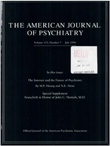Use of ECT in the United States in 1975, 1980, and 1986
Abstract
OBJECTIVE: The objective was to analyze nationally representative data from the National Institute of Mental Health (NIMH) to update trends in the use of ECT in the United States. METHOD: The data are estimates from the NIMH Sample Survey Program for 1975, 1980, and 1986, which include representative samples of inpatients in psychiatric facilities in the United States. The authors' analyses use trend data from public general hospitals, private general hospitals, private psychiatric hospitals, and state and county mental hospitals. They report on 126,739 patients who received ECT in 1975, 1980, and 1986, focusing on data from 1980 and 1986. RESULTS: In 1986, 36,558 patients received ECT. This represents a decrease from the 1975 figure (58,667 patients) but no change from 1980 (31,514 patients). ECT was used primarily in private general hospitals (64%) and private psychiatric hospitals and much less often in public general hospitals and state and county mental hospitals. In 1986 over 90% of ECT recipients were white, and 84% had an affective disorder diagnosis. Although 71% of the patients who received ECT were women, hospital type and age were more important than gender in predicting ECT use. Individuals 65 years of age and older received ECT out of proportion to their numbers in inpatient care. CONCLUSIONS: The declining use of ECT in the United States ended in the 1980s. Few African Americans receive ECT, and its use is becoming more targeted toward patients with affective disorders. The amount of services research done on this modality is very small. Basic questions have yet to be answered, including who refers patients for ECT and why, and how ECT fits into the overall course of treatment.
Access content
To read the fulltext, please use one of the options below to sign in or purchase access.- Personal login
- Institutional Login
- Sign in via OpenAthens
- Register for access
-
Please login/register if you wish to pair your device and check access availability.
Not a subscriber?
PsychiatryOnline subscription options offer access to the DSM-5 library, books, journals, CME, and patient resources. This all-in-one virtual library provides psychiatrists and mental health professionals with key resources for diagnosis, treatment, research, and professional development.
Need more help? PsychiatryOnline Customer Service may be reached by emailing [email protected] or by calling 800-368-5777 (in the U.S.) or 703-907-7322 (outside the U.S.).



